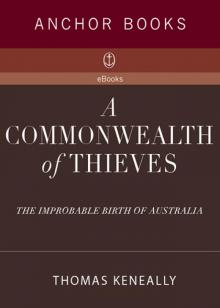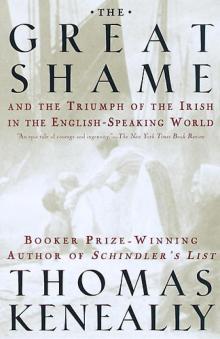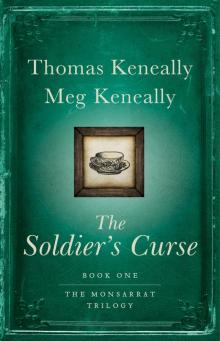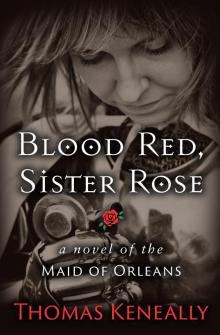- Home
- Thomas Keneally
Australians, Volume 2 Page 9
Australians, Volume 2 Read online
Page 9
The team left for England in February 1868 on the Parramatta. The base of the team was in Kent, but after their first match at the Oval, attended by 7000 spectators in picnic mood—and which the Australians played with loud enthusiasm, and lost—their journeying became hectic. They travelled on most of their rest days and had little time for practice. In mid-June they played the MCC (Marylebone Cricket Club) at Lord’s, the MCC declaring it wanted no athletic feats performed in the intervals. But here too, at public demand, the team was required to participate in shows of native skill. A poster for the game at Trent Bridge in Nottingham shows us what some of these were. There were eleven events in which amateurs could pit themselves against the Aborigines, including feats such as the standing high jump and throwing the cricket ball, at which Dick-A-Dick excelled, just edged out on three occasions by the famous Englishman, W.G. Grace. Mock battles were also fought in which three of the team spear throwers would accurately hem in but miss three others standing nearly 90 yards (about 80 metres) distant. Dick-A-Dick could also parry cricket balls thrown from fifteen to twenty yards away with a narrow native shield.
A conscientious sergeant of police from Edenhope had warned before the team left Victoria that some of them had chest problems. Not long after the Lord’s game—during which Yellanach was again the star bowler, taking ten wickets in the MCC’s two innings, including those of an earl and a viscount—King Cole (Bripumyarrumin) died of tuberculosis at Guy’s Hospital in London and was buried at the Victoria Park cemetery. The impact of this on the other players is not recorded, but their fear of the naming of the dead, and of what damage a disgruntled spirit far from home might wreak, must have been intense.
After their ten games in the south of England, of which they won only one, they moved northwards, beginning to achieve success as they went, winning fourteen matches, losing an equal number and drawing nineteen. They were sensitive to racial slurs and Mullagh, after being insulted at York, played sullenly. When less discontented, he and Cuzens, together with their white captain, Lawrence, were the best bowlers and batsmen. Cuzens’ score of 87 at Norwich was typical of his skill. At Reading, Mullagh scored 94, in an age when centuries were rare.
The players returned home on two ships which left England in October. On their arrival in Australia in February 1869, they played one of their final matches against a combined team from the sailors of Prince Alfred’s HMS Galatea and the Victorian garrison. The prince, recuperating from being wounded by an Irishman in Sydney, himself attended. Even as they played that game, the Protection Board was in the midst of founding four reserves for Aborigines, including one named Flamlington near Warrnambool, which was meant to contain the Jardwadjali players and their clansfolk.
Mullagh and Cuzens returned to their home country after playing for the Melbourne Cricket Club and tried not to be gathered into the reserve. Mullagh would play for Victoria in 1879 against Lord Harris’s touring English XI. He became a rabbit-trapper and died a respected man in 1891. Other Aborigines disliked the new reserves, and Hugh McLeod of Benayeo and A.A. Cowell of Brippick Station permitted groups to live on their properties and supplied them largely from their own pockets. The former members of the cricket team, Peter (Arrahmunyarrimun) and Tiger, lived on these stations. Dick-A-Dick, who also played professional cricket in Melbourne, eventually returned to Mount Elgin Station and worked as a drover. He would ultimately be awarded a ‘king-plate’—a gorget for wearing round the neck—which proclaimed him to be King Billy. (Kingship was of course a concept unfamiliar to Aboriginal culture.) He adopted the name Kennedy after the Edenhope police constable who had helped him since his boyhood.
OVERLAND TELEGRAPH
The Northern Territory was the preserve of South Australia until 1910. In 1870 the South Australian government sent a party to the north coast by ship to select a port for a settlement. The port named Palmerston near Escape Cliffs was created with a small staff of administrators, six officials and thirty-eight men under the management of Dr J.S. Millner. A less-than-gifted South Australian official named Captain William Bloomfield Douglas soon took over as permanent Government Resident and hoped to become a local satrap in the manner of his grand relative, Sir James Brook, who had ruled as the white Rajah of Sarawak. By his lordly manner Bloomfield alienated all the Darwin officials he had to deal with, and by his financial incompetence lost favour in Adelaide.
The local Larakia tribe, who had encountered Europeans earlier through a party led by the South Australian surveyor George Goyder, looked upon the settlement with curiosity and were attracted and pacified by gifts of food and axes. Axes transformed a man from a warrior of stone to a warrior of iron, and as everywhere else created immediately a temporary elite of hatchet-men, at least until everyone acquired one. Flour was a deliverance from the time-devouring business of harvesting and pounding native grasses. It must have seemed a miraculous ‘convenience food’. It was the Woolna people further to the east who would prove, in European terms, intractable and ‘mischievous’. But for most of the perhaps 50 000 natives of the Territory, the European intrusion was for the moment too minuscule to make a dent in their lives. An overland telegraph would be the beginning of change, however.
The small, vigorous, stubborn English astronomer and telegraphic expert Charles Todd had come to South Australia in 1855 to build the telegraph lines throughout that colony, having been nominated for the job by his superior, the astronomer royal, Sir George Airy. Even in the late 1850s, Todd, still in his early thirties, began to plan for a telegraph connection between South Australia and Melbourne and Sydney. Todd had also created a series of meteorological stations in South Australia, which began operating in the early 1860s. He made friends with the Victorian Superintendent of Electric Telegraphs, Samuel McGowan, and together they persuaded South Australia and Victoria to finance a line laid down under Morse’s system. The British themselves were recommending telegraph connection to Australia—it had already been established between England and India, and it could be extended south to Singapore and the Dutch East Indies. A sea cable could be laid around the east coast of Brisbane then, and thence a land line to Sydney. Todd, who showed great skill when it came to dealing with decision makers, assessed all these plans. But John McDouall Stuart’s crossing of the continent in 1862 made Todd think of a telegraph overland all the way from Adelaide to the northern coastline of Australia.
Early in 1870 the British Australian Telegraph Company, which was laying cable from its ships in the seas north of Australia, sought permission from the Premier of South Australia, Henry Bull Templar Strangways, to land the line at the barely peopled little port of Palmerston, and Strangways decided that an overland line should be built from Adelaide to meet it. For this task Todd—now Postmaster-General as well as Superintendent of Telegraphs—needed more survey time than the politics of the situation and the urgency of the British Australian Telegraph Company would permit him. He had to fall back on the maps and documents of Stuart’s expedition.
He divided the work of creating the line into three sections, the southern and northern being let out to contractors under the supervision of Todd’s overseers, and the central to be done by government labour under his direct management. The Aborigines through whose land the line passed looked at it with some interest but did not seem to see it as representing the same scale of intrusion new pastoral stations had. Occasionally they set fire to the poles, since they were good sources of fuel in a land of mere undergrowth, and the porcelain conductors looked fascinating. The repeater stations, placed every 180–300 miles (300–500 kilometres) to on-forward messages down the line, were now built with materials available in the region (often of stone) and staffed by telegraphists. The telegraph was completed in 1872 and for the first time created an expensive but as good as immediate communication with Europe.
The repeater stations along the line began to change native life by serving as bases for gold prospectors and pastoralists—as was
the case at Pine Creek, where a gold rush began almost simultaneously with the building of the Pine Creek repeater station. Other repeater stations to pass the communications of Australian businesses and governments northwards to the greater world were based at Tennant Creek and Alice Springs to the south, where further settlement gathered.
GOYDER AND ALL THAT
To emphasise the matter of dryness and the limitations it placed on colonial expectations, in South Australia young surveyor George Goyder adjusted to what had been found, and what had not been, and in 1865 drew a line across the southern reaches of the colony, in substance following the 10 inch isohyets beyond which less than 25 centimetres of rain fell a year. North of the line was country where the droughts had already destroyed many prospective settlers and where no one could expect to grow cereals or pursue other agriculture. In the mid-1870s, when South Australia experienced higher than average rainfall, settlement extended over Goyder’s Line, and the South Australian government helped farmers to settle nearly as far north as Lake Eyre, the great salt lake many considered the abomination of desolation at Australia’s heart. Whenever the lake was flooded it fed rivers, including the Georgina, the Diamantina and the Cooper. But in bad times, the validity of Goyder’s Line became tragically apparent to all.
It was thought that artesian water would be the answer to the Australian reality. Artesian wells, which had been first dug in Artois in northern France, tapped water lying beneath the earth, often between layers of impermeable rock. In 1879 Ralph Tate, professor of palaeontology from Adelaide University, travelled to Lake Eyre and found water gushing from hummocks. This was artesian water, closer to the surface here because this was the western outer rim of a huge saucer, the Great Artesian Basin, most of it lying beneath Queensland but also beneath parts of the Northern Territory, South Australia and New South Wales. The other side of the saucer on whose rim Tate stood lay on the western side of the Great Dividing Range in Queensland. The basin would prove to contain over 650 000 square miles (1.7 million square kilometres) of submerged water. So there might be no desolation at all—the much-needed living water ran beneath the rock!
At this stage a pair of Vandemonian brothers, Charles and Suetonius Officer, were running cattle at Killara near Bourke, close to the centre of the Great Artesian Basin. When in 1878 their cattle trampled down a mound spring and reduced it to a morass, the manager David Brown used a mechanical rig to drill 1800-feet (550-metre) bores. One of them spouted up 13 000 gallons (58 000 litres) per day. Near another mound spring Brown sank a second bore and hit water at less than 20 feet (6 metres).
Stockmen on neighbouring country taken over by the technically minded cattle king Samuel McCaughey also struck water. In that same year, the Victorian government began to drill in the Western District. The news that there was artesian water beneath the ground provided the Australian pastoral and agricultural imagination with a subterranean Mississippi, a redemptive lake. God had veiled the true promise of Australia and destroyed the unwise, but now promise was revealed. In Queensland, in the drought of the early 1880s, the government began to build tanks and dams on the stock routes throughout the bush, with government engineers sinking wells in such places as Winton, a town that was barely self-sufficient in water. Simon Fraser, grandfather of the twentieth-century politician Malcolm Fraser, had been running cattle in Queensland since the 1860s and did not consider the conserving of water to be entirely the government’s responsibility. He had heard of artesian finds from his brother-in-law and he engaged a Canadian well borer named J.S. Loughead to drill on his company’s Thurulgoona Station, 50 kilometres from Cunnamulla. Loughead’s machinery could drill nearly 1600 metres into the earth. In the summer of 1886 he discovered a submerged reservoir of water at just under 520 metres and from it came 2.1 million litres per day. Loughead drilled similar deep bores at Barcaldine in January 1888 and at Blackall. Grazing could now be extended into country that had previously proved untenable, and squatters poured into the Artesian Basin country in Queensland, New South Wales and South Australia. By the early 1900s, when there were 1500 bores, some of the disadvantages became apparent. So much drilling released pressure in the hidden water and flows became more modest.
Though artesian water extended pastoral possibilities, and allowed cattle to degrade an even larger part of the surface of remoter Australia with their hard hoofs, it did not make the wilderness bloom and did not generate cities. Artesian water also meant that more Aborigines, accomplished in living in arid regions kept safe from intrusion by their very dryness, were now driven off land they had thought till now they securely possessed.
THE ASIAN SOUTH AND NORTH
North or south, the Asian miner attracted rancour. One of the many grievances white miners had against the Chinese is that they did not participate in the struggle for miners’ rights. It was true that there had been no Chinese miners at Eureka, though the question arises as to whether they would have been welcomed into the rebel ranks. The first wide-spread outbreak against the Chinese had occurred in 1861 at Lambing Flat, the future town of Young, where 13 000 diggers had gathered. Two thousand Chinese joined the Europeans and were described by the Lambing Flat paper as a ‘swarm of Mongolian locusts’. After a large meeting at which there was a great deal of inflammatory rhetoric, the miners from Tipperary Gully marched into Lambing Flat, collecting men as they went, and then moved on towards Victoria Hill where the Chinese were working. The physical harm to the Chinese was not as extreme as the oratory which preceded the riot, but it did involve the riding down of Chinese and whipping them. Their tents were burned, however, and much of their gold, dredged by great labours, was plundered.
At Back Creek 500 more Chinese were attacked. The bank clerk Preshaw in Kiandra wrote of a white woman married to a Chinaman who was ‘maltreated by the mob’; her child narrowly escaped death when miners set fire to the infant’s cradle. According to the Sydney Morning Herald, some attackers cut off Chinese pigtails ‘with the scalp attached’.
On 14 July 1861 a party of constables arrested three of the rioters, whereupon 3000 miners marched on the police camp with guns and sticks. One white miner was killed in the attack and others were wounded when a detachment of mounted troopers charged the mob with drawn swords, forcing them to flee, some of them bleeding from wounds to their faces and heads. The fury this created amongst the miners and the risk of retaliation drove the police and troopers to retreat to Yass to await reinforcements. Soldiers and artillery were sent from Sydney and, arriving on the goldfields, imposed a sullen order. Eleven miners were charged but acquitted by juries who favoured them. The Chinese of the area hid or left for other goldfields, or in many cases took up other occupations, as reapers, shearers, carters of wood and water, tailors, carpenters or hawkers of fish, vegetables and fancy items.
The Yass Chinese merchant Lowe Kong Meng wrote, ‘If such a thing had happened in China—if a number of English miners had been subjected to such cruel and wanton outrage—every newspaper in Great Britain would have been aflame with indignation.’ The reaction in New South Wales was, however, the passing of the Chinese Immigration Restriction Act of November 1861, which imposed a Chinese residency tax similar to one already in place in Victoria.
Northern Australia was considered an unfit territory for European women, a zone of degeneracy and fever. Metropolitan Australia accepted that but it also harboured a considerable anxiety about what was happening up there and the dangers of tropical Australia becoming ‘Mongrelia’ and ‘Piebald Australia’. On the Great Chain, the external racial challenge was still, above all, the Chinese. The Chinese had arrived in small numbers in Queensland by 1860, at gold diggings at Gympie but further north as well, at Cape River, Crocodile Creek and the Gilbert River. Although by 1870 there were only 2000 Chinese, the Palmer River goldfield near Cooktown would attract 1000 a week during April 1874 and there were 18 000 miners from southern China on the Palmer goldfield alone by the middle of 1877. An
anonymous poet in Queensland Punch expressed the standard hostility.
Though we annoy them as much as we dare
Fair play or foul, they are more than a match for us . . .
They’ll be our bosses and we’ll grow their cabbages
If they go on the way they’ve begun.
In 1874, the South Australian government had entered a contract with the Netherlands India Steam Navigation Company to include Adelaide in their route to China and back a stop in Port Darwin. This created further editorialising and concern. The Cooktown Courier declared, ‘In a very short time the Great Wall of China will encircle the Palmer, and the “outer barbarian”, the unfortunate digger, will have to look for fresh fields.’
An editorial in Northern Miner on 26 May 1877 pushed the would-be scientific line. ‘Kanakas [indentured Melanesian labourers] and Chinese are distinct types of the genus Homo—some would go so far as to deny that they belong to the human family at all. There is no affinity between them and men of the Caucasian race, and miscegenation of races so physically antagonistic must inevitably degrade the higher race.’
The Ingham Hospital publicly declared that it excluded from its admittance lists:
An African because he is black;
A Malay because he is Asiatic;
A Native of New Caledonia because he is a South Sea Islander.
The Chinese were in Cairns from 1877 when the town started, having moved there from the Palmer River goldfields up the coast. In the hinterland they made up almost half the population in tropical North Queensland. Many of them worked under contract to clear the tropical rainforest on blocks selected by Europeans under the Queensland Land Acts of 1876 and 1884, acts which excluded the Chinese themselves from land ownership. Chinese workers cleared land energetically by a method called ‘scarfing’, setting up a domino effect in the trees. Once the clearance work was done, they often hired land back and grew plantations of bananas. The Hop Wah plantation was established outside Cairns in 1879 by a syndicate of 100 Chinese. These growers shipped the bananas down to the coast on sampans and then transferred them to junks, which took them into Cairns. About fifteen junks operated in the area of Trinity Bay north of Cairns, where rivers such as the Barron, flowing down from the Atherton Tablelands, entered the sea. The junks themselves were made from cedar logs felled in the rainforest by full-time Chinese boat builders.

 Confederates
Confederates Flying Hero Class
Flying Hero Class Gossip From the Forest
Gossip From the Forest Schindler's List
Schindler's List Bring Larks and Heroes
Bring Larks and Heroes Australians: Flappers to Vietnam
Australians: Flappers to Vietnam The People's Train
The People's Train Crimes of the Father
Crimes of the Father A Family Madness
A Family Madness A Commonwealth of Thieves
A Commonwealth of Thieves Ned Kelly and the City of Bees
Ned Kelly and the City of Bees A River Town
A River Town Bettany's Book
Bettany's Book Blood Red, Sister Rose: A Novel of the Maid of Orleans
Blood Red, Sister Rose: A Novel of the Maid of Orleans Victim of the Aurora
Victim of the Aurora American Scoundrel American Scoundrel American Scoundrel
American Scoundrel American Scoundrel American Scoundrel Three Cheers for the Paraclete
Three Cheers for the Paraclete Australians: Origins to Eureka: 1
Australians: Origins to Eureka: 1 The Power Game
The Power Game The Chant Of Jimmie Blacksmith
The Chant Of Jimmie Blacksmith The Daughters of Mars
The Daughters of Mars Searching for Schindler
Searching for Schindler The Great Shame: And the Triumph of the Irish in the English-Speaking World
The Great Shame: And the Triumph of the Irish in the English-Speaking World Abraham Lincoln
Abraham Lincoln The Widow and Her Hero
The Widow and Her Hero Eureka to the Diggers
Eureka to the Diggers Shame and the Captives
Shame and the Captives The Survivor
The Survivor Jacko: The Great Intruder
Jacko: The Great Intruder The Book of Science and Antiquities
The Book of Science and Antiquities Homebush Boy
Homebush Boy The Playmaker
The Playmaker To Asmara: A Novel of Africa
To Asmara: A Novel of Africa A Woman of the Inner Sea
A Woman of the Inner Sea The Tyrant's Novel
The Tyrant's Novel Australians
Australians Schindler's Ark
Schindler's Ark The Soldier's Curse
The Soldier's Curse Australians, Volume 3
Australians, Volume 3 Blood Red, Sister Rose
Blood Red, Sister Rose A Victim of the Aurora
A Victim of the Aurora The Unmourned
The Unmourned Australians, Volume 2
Australians, Volume 2 To Asmara
To Asmara